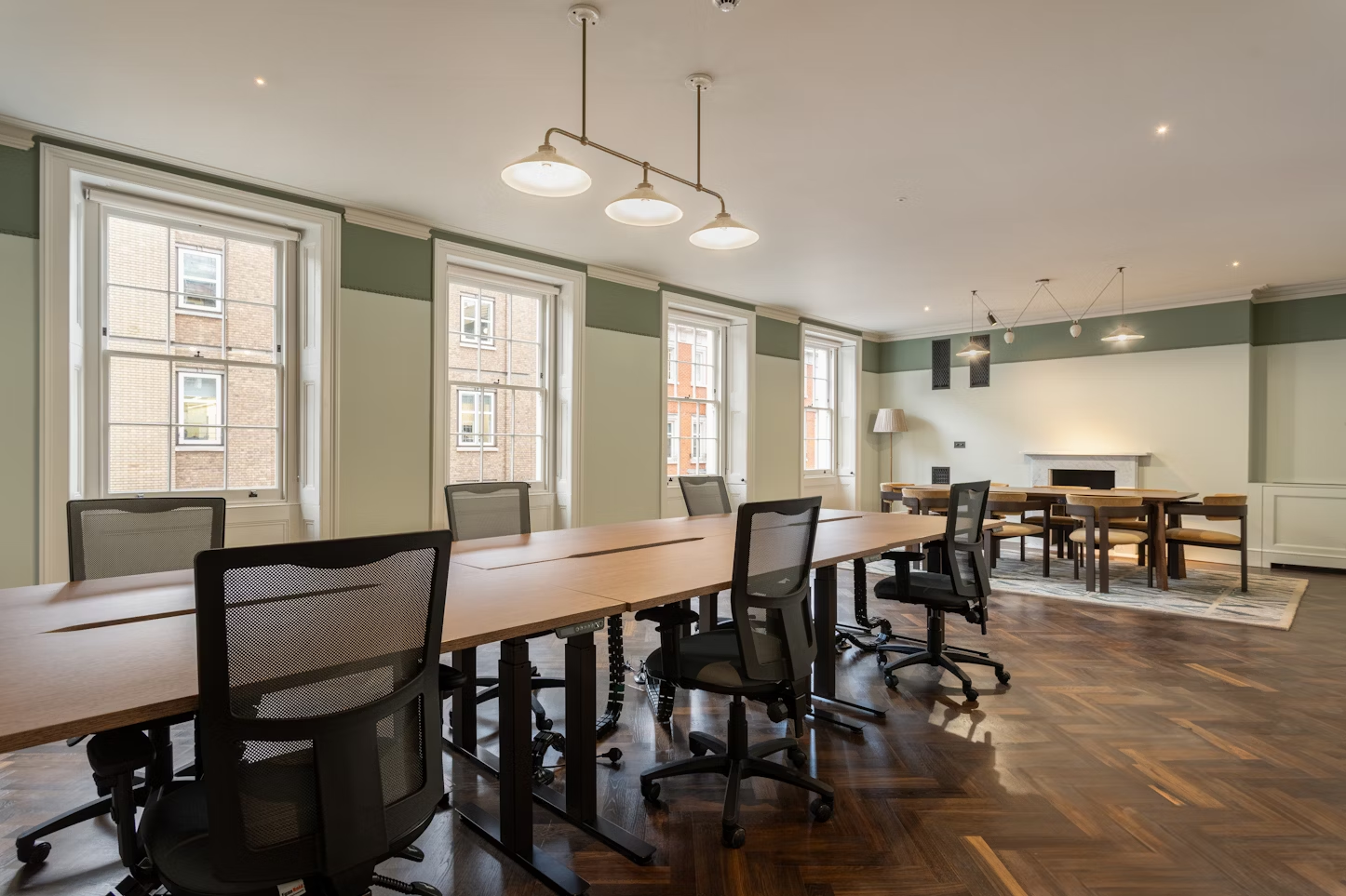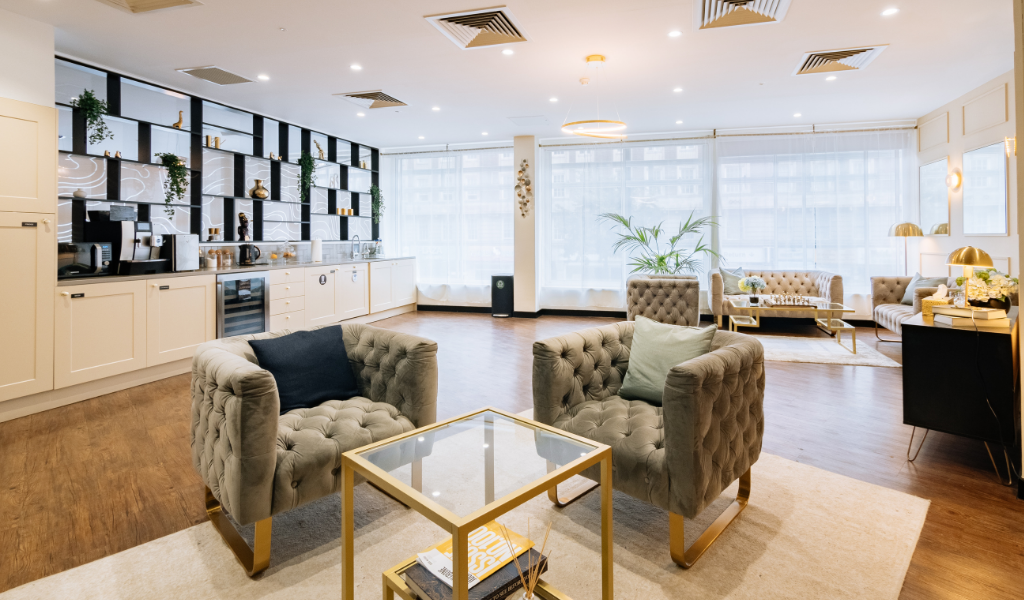Getting your office size right is more important than ever in 2025. Take too much space and you’re burning budget. Take too little, and you risk cramping your team’s productivity and morale.
So, how do you strike the perfect balance?
Here’s our take on space planning, backed by market stats, years of experience, and a practical tool to help you get budgeting right – Flex Office Solutions Rent Calculator.
The Goldilocks Problem: Not Too Big, Not Too Small
One of the most common pitfalls we see with office planning is misjudging space. Especially in Central London, where cost per square foot adds up quickly.
Too little space can lead to:
- Overcrowding
- Low morale
- Difficulty hosting clients
- Limited meeting or break-out areas
Too much space often results in:
- Paying for empty desks
- Wasted utility, service charges and/or higher business rates
- Reduced energy and buzz in the workplace
In short, neither extreme works. And getting it wrong can have financial and cultural consequences. It’s worth noting that average space per person in London dropped almost 19% from 2019 to 2023, as many businesses initially downsized during the pandemic[1].

A Quick Look at the Data
According to 2024 market data, 78% of Central London occupiers expanded their office footprint in 2024[1]. That might surprise you, especially in the era of hybrid working, but we think it speaks volumes.
Our take?
Many businesses initially downsized too aggressively post-Covid, only to find that they needed more space for team collaboration, meetings, and growth. Hybrid doesn’t mean “tiny office” – it means smarter space.
We’re now seeing companies “right-size” their offices, not just based on headcount, but on how they work.
In London, average desk prices range from £400 – £700 per month, depending on location and amenities[1]. Sub-2,000 sqft spaces often offer the best balance between functionality, flexibility, and cost-per-head. In Central London:
- Under 2,000 sqft: You benefit from price compression – many providers compete aggressively here, so rates tend to be more attractive.
- Over 2,000 sqft: You start entering a different bracket – Fit-out costs increase. Larger footprints usually mean longer lease terms, and fewer plug-and-play options.
Our take?
If you’re a growing business, 2,000 sqft is a crucial tipping point. Staying just below it often gives you the flexibility and value of serviced or managed space, without being locked into longer leases or upfront capital investment. But if you do need more room, for breakout areas, a boardroom, or a larger team, it’s worth weighing up longer-term costs vs operational freedom.

Occupiers Are Rightsizing, Not Downsizing
A report highlights that over 60% of occupiers are actively reviewing their office footprint, with a clear trend toward “rightsizing” rather than mass exit.
“There’s a growing appetite for flexible terms and buildings that offer shared amenities, sustainability credentials, and plug-and-play ease[2]”
This aligns with our experience, many clients are shifting from long-term, underutilised leases to scalable, flexible solutions that match their team’s actual in-office patterns.
SMEs Are Re-Evaluating Cost vs. Culture
For SMEs, the decision often comes down to balancing budget with workplace experience. Reports found that 48% of small business owners plan to adjust their office space in the next 12 months, primarily to manage costs or support hybrid working[3].
At the same time, SMEs ranked “creating a positive work environment” as a top-three priority for 2024[3], showing that space still matters, even as footprint shrinks.
What Do Employees Actually Want?
According to a survey, of over 250,000 employees globally, only 41% of respondents said their current office supports both individual and collaborative work effectively. That same report found that employees want environments that reflect “flexibility, choice, and purpose”—a layout that matches the task at hand[4]. Concluding:
“The workplace of the future isn’t smaller, it’s smarter.”[4].
Things to Consider When Planning Your Space
Beyond the calculator, here are a few smart questions to ask:
1. Are We Planning for Tomorrow, or Just Today?
Don’t just plan for today. A recent survey showed that 42% of London SMEs expect to increase headcount in the next 12 months[1]. Make sure your office space can scale with you, either with expansion options or built-in flexibility.
2. How Do We Actually Work?
Hybrid teams may not need a desk for every team member, but they do need the right mix of space, from hot desks to breakout zones and meeting areas. Hybrid teams generally need 60–70% of desks compared to pre-Covid setups.
But you’ll still need space for all-hands, collaboration, and those “everyone in” days. In fact, 67% of hybrid employees say in-person collaboration is the #1 reason they come into the office[1]. Which flexible office space can cater for versus traditional leasing.
If you’re client-facing or creative, more meeting rooms and informal zones can be just as important as desk space.
3. Are We Maximising Cost Efficiency?
Sometimes two smaller offices across flexible terms are better than one oversized HQ. Sometimes a managed space with shared amenities (like breakout areas and phone booths) lets you cut square footage without sacrificing functionality.
Our advice? Don’t just focus on £/sqft. Look at cost per person, flexibility, and use of space. That’s where the real value is.
Final Thought
There’s no one-size-fits-all when it comes to office space but there is a smarter way to figure it out.
Use data, use tools, and talk to experts who understand how your business actually works. We’ve helped teams of 5 and teams of 50+ find the right setup, whether that’s a private floor in Soho or a flexible desk-and-meeting-room combo in Shoreditch.
Ready to figure out how much space you really need? Contact us today here.
References
[1] Knight Frank (2023). London Office Space: Utilisation and Trends Post-Pandemic.
[2] CBRE (2024). London Office Occupier Trends Q1 2024.
[3] London Chamber of Commerce (2024). SME Business Confidence Barometer Q1 2024.
[4] Leesman Index (2023). Hybrid Working and the Modern Office Report.

